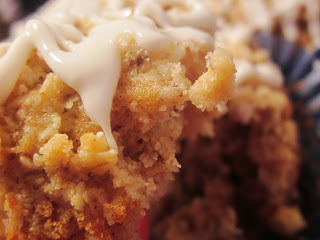Who knew that Freeze Dried Mangos and
6 Grain Pancake Mix could make amazing cupcakes?Here's my recipe:
Gingered Mango Crumb Cakes drizzled with White Chocolate
2 1/2 cup THRIVE 6 grain pancake mix
2 cup Honeyville Freeze Dried Mango (hydrate with 1 cup hot water for 10 minutes)
3/4 cup Organic Coconut Oil
3/4 cup sugar
4 large eggs (or dehydrated Powdered Egg Whites, hydrated to equal 1 cup of liquid)
4 large eggs (or dehydrated Powdered Egg Whites, hydrated to equal 1 cup of liquid)
2 tsp pure vanilla
1/2 tsp rum or brandy flavor
3/4 cup Quick Rolled Oats
1 T ground ginger
1 tsp ground cinnamon
Crumb topping:
2 1/3 cup THRIVE 6 grain pancake mix
1/2 cup coconut oil
2/3 cup sugar
1 tsp ginger
1/2 tsp ground cardamom
Directions: Preheat oven or solar oven to 325 degrees. Lightly oil muffin pans and line with cupcake papers. (Yields 24). In a large bowl, combine the hydrated fruit, oil, sugar, egg, vanilla and flavor. Whisk until well combined. In a separate bowl combine pancake mix, oats, ginger and cinnamon. Combine the wet and dry ingredients and mix by hand 100 strokes. Scoop into cupcake cups, filling half full. Top with crumb topping. To make crumb topping, combine ingredients for crumb topping until it looks like this:
Chopped toasted macadamia nuts sprinkled on top of the chocolate might make me pass out...
There you go! Another way to use your pancake mix! Enjoy!
1/2 cup coconut oil
2/3 cup sugar
1 tsp ginger
1/2 tsp ground cardamom
Directions: Preheat oven or solar oven to 325 degrees. Lightly oil muffin pans and line with cupcake papers. (Yields 24). In a large bowl, combine the hydrated fruit, oil, sugar, egg, vanilla and flavor. Whisk until well combined. In a separate bowl combine pancake mix, oats, ginger and cinnamon. Combine the wet and dry ingredients and mix by hand 100 strokes. Scoop into cupcake cups, filling half full. Top with crumb topping. To make crumb topping, combine ingredients for crumb topping until it looks like this:
Top cupcakes. Bake 15-18 minutes until a toothpick inserted in the center comes out clear. I drizzle with 8 oz of melted white chocolate when cooled.
Chopped toasted macadamia nuts sprinkled on top of the chocolate might make me pass out...
There you go! Another way to use your pancake mix! Enjoy!
















































